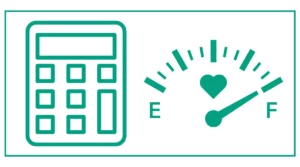Dress Size Calculator
The dress size calculator helps you find the perfect dress 👗 for you. You can now easily find your US, UK, and international dress sizes.
Enter your bust size in cm, waist size in cm, and hip size in cm. Hit the calculator button to see the dress size suggestions.

Understanding Dress Sizes
Dress sizes can vary significantly between countries, brands, and even different styles within the same brand. This inconsistency often leads to confusion and frustration for shoppers. To complicate matters further, there's no universal standard for dress sizes, which means a size 8 in one brand might fit like a size 10 in another.
The Importance of Accurate Measurements
The key to finding the right dress size lies in knowing your body measurements. Accurate measurements are crucial for:
- Comparing your dimensions to size charts
- Using online size calculators effectively
- Communicating with tailors or seamstresses for alterations
Taking your measurements regularly is essential, as body shape and size can change over time due to factors like weight fluctuations, pregnancy, or aging.
How to Measure Yourself for a Dress
To get the most accurate measurements, use a flexible measuring tape and follow these steps:
Bust Measurement
- Stand straight with your arms relaxed at your sides.
- Wrap the measuring tape around the fullest part of your bust.
- Ensure the tape is parallel to the floor and not too tight.
- Take note of the measurement in both inches and centimeters.
Waist Measurement
- Locate your natural waistline, which is typically the narrowest part of your torso.
- Wrap the measuring tape around your waist, keeping it parallel to the floor.
- Breathe normally and don't suck in your stomach.
- Record the measurement.
Hip Measurement
- Stand with your feet together.
- Measure around the widest part of your hips and buttocks.
- Keep the tape parallel to the floor.
- Note down the measurement.
Length Measurement
- For dresses, measure from the top of your shoulder to where you want the hem to fall.
- For skirts, measure from your natural waistline to the desired hem length.
Remember, these measurements are just a starting point. Factors like your height, body shape, and personal preferences for fit will also play a role in finding the perfect dress size.
Using a Dress Size Calculator
A dress size calculator can be an invaluable tool in determining your size, especially when shopping online. Here's how to use the dress size calculator provided in the HTML code:
- Open the calculator in your web browser (e.g., Chrome, Firefox).
- Enter your bust measurement in centimeters in the "Bust" field.
- Input your waist measurement in centimeters in the "Waist" field.
- Enter your hip measurement in centimeters in the "Hips" field.
- Click the "Calculate Dress Size" button.
The calculator will then display your dress size in various formats:
- US size
- UK size
- EU size
- International size (XXS, XS, S, M, L, XL, XXL)
It will also provide specific information about your waist and hip sizes.
Benefits of Using a Dress Size Calculator
- Saves time by quickly converting your measurements to various size standards.
- Helps you shop across different brands and countries more confidently.
- Reduces the likelihood of ordering the wrong size, especially when shopping online.
- Provides a starting point for finding your perfect fit, which you can then adjust based on personal preferences and brand-specific sizing.
Understanding Size Charts
Size charts are essential tools provided by most clothing brands to help you find the right fit. Here's how to effectively use a size chart:
- Locate the size chart on the brand's website or product page.
- Compare your measurements to those listed in the chart.
- If your measurements fall between two sizes, it's generally recommended to choose the larger size.
- Pay attention to any notes about fit (e.g., "runs small" or "relaxed fit").
Size Chart Variations
Keep in mind that size charts can vary significantly between brands and even between different styles within the same brand. Some factors that can affect sizing include:
- The cut of the dress (e.g., fitted, loose, A-line)
- The fabric used (some materials have more stretch than others)
- The intended fit (some dresses are designed to be form-fitting, while others are meant to be looser)
Always refer to the specific size chart for the dress you're interested in, rather than relying on a general size chart for the brand.
Size Conversions
Understanding size conversions is crucial when shopping internationally or across different sizing standards. Here's a general guide to size conversions:
| US Size | UK Size | EU Size | International Size |
|---|---|---|---|
| 00 | 2 | 30 | XXS |
| 0 | 4 | 32 | XS |
| 2 | 6 | 34 | XS |
| 4 | 8 | 36 | S |
| 6 | 10 | 38 | S |
| 8 | 12 | 40 | M |
| 10 | 14 | 42 | M |
| 12 | 16 | 44 | L |
| 14 | 18 | 46 | L |
| 16 | 20 | 48 | XL |
| 18 | 22 | 50 | XL |
| 20 | 24 | 52 | XXL |
Remember, this is a general guide, and actual conversions may vary between brands. Always check the specific brand's size chart for the most accurate information.
Tips for Finding the Perfect Dress Size
- Don't focus solely on the number: Size is just a guide. How a dress fits and feels is more important than the number on the label.
- Consider your body shape: Different dress styles flatter different body shapes. Understanding your body type can help you choose dresses that enhance your best features.
- Pay attention to fabric: Some fabrics, like stretchy jersey, are more forgiving in fit than structured materials like cotton or silk.
- Read customer reviews: Other shoppers often provide valuable insights about fit and sizing in their reviews.
- Be prepared to tailor: Sometimes, finding a dress that fits perfectly off the rack is challenging. Budget for potential alterations to achieve the best fit.
- Try before you buy: If possible, try on dresses in-store before making a purchase. This allows you to assess the fit, comfort, and how the dress looks on your body.
- Check the return policy: When shopping online, ensure the retailer has a good return policy in case the dress doesn't fit as expected.
FAQs About Dress Sizes
How often should I measure myself?
It's a good idea to measure yourself every few months or whenever you notice significant changes in your body shape or weight.
What if my measurements don't align perfectly with the size chart?
If your measurements fall between sizes, it's generally best to choose the larger size. You can always have a dress taken in, but it's more difficult to let one out.
Are dress sizes the same as other clothing sizes?
Not necessarily. Dress sizes can differ from sizes for other types of clothing, even within the same brand. Always check the specific size chart for dresses.
How do I measure for a long dress or maxi dress?
In addition to the standard measurements, you'll need to measure from your shoulder to the floor (or to where you want the hem to fall) to ensure the proper length.
Can I use this dress size calculator for all brands?
While this calculator provides a good starting point, it's always best to refer to each brand's specific size chart for the most accurate sizing information.
What if I'm pregnant or between sizes?
If you're pregnant or your size is fluctuating, consider dresses with adjustable features or stretchy fabrics. You may also want to size up for comfort.





